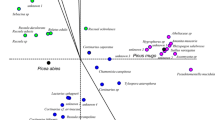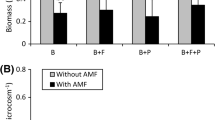Abstract
A study of mycorrhizal activity was conducted in a mature Norway spruce ((Picea abies) [L.] Karst.) stand subjected to soil treatments of liming and acidification for six years (Höglwald research project). Samples were collected five times during one growing season using a soil corer. All the turgescent, not shriveled mycorrhizal tips were sorted out and identified on the fungal species level as far as yet possible. The proportion of each mycorrhizal type on the plots was calculated. The results revealed a shift in the mycorrhizal communities caused by both acid rain and liming. Data are in agreement with the findings of the more comprehensive study on the mycorrhizal communities carried out by another research group on the same plots (Taylor et al., submitted)
The activity of the predominant types of mycorrhizas, Piceirhiza gelatinosa, Piceirhiza nigra, Russula ochroleuca-P. abies, Tuber puberulum-P. abies, Tylospora sp.-P. abies, Xerocomus badius-P. abies, was investigated by staining hand sectioned tips with FDA and their fluorescence. Different FDA-hydrolysing activities of the mycorrihizal types had been found in a previous-year study on the same plots and were confirmed during the second year. The proportion of the different stages of activity of the mycorrhizal tissues was calculated on the type level and in connection to the soil treatments. X. badius-P. abies and R. ochroleuca-P. abies displayed the most active fungal tissues and proportion increased on the acidic plots while Tuber puberulum-P. abies and Piceirhiza nigra were the most active types and occurred in higher proportion after liming. Thus, the overall activities of the mycorrhizas were only slightly changed by the treatments. In addition to the mycorrhizal effect acidification reduced while liming enhanced the meristematic activity of the short root tips. The same tendency was found by studying root production on the same plots (Hahn and Marschner, 1998). Although nearly 3000 mycorrhizal tips were studied, the data are still limited, allowing no statistical validation. This is, however, the first investigation connecting overall activity of the mycorrihizal tissues with the proportion of the mycorrhizal types as influenced both by alterations of the forest soil caused by acid rain and liming. The results are interesting and reasonable but further investments are necessary to validate the general conclusions.
Similar content being viewed by others
References
Agerer R 1987–1996 Colour Atlas of Ectomycorrhizae. Einhorn Verlag E. Dietenberger, München.
Agerer R, Klostermeyer D and Steglich W 1995 Piceirhiza nigra an ectomycorrhiza on Picea abies formed by a species of Thelephoraceae. New Phytol. 131, 377–380.
Babel U 1981 Humusmorphologische Untersuchungen in Nadelholzbeständen mit Wuchsstörung. Mitt. Verein Forstl. Standortskd. Forstpfl. 29, 7–20.
Blaschke H 1980 Feinwurzeluntersuchungen und biotische Aktivitäten in der Rhizosphäre von vom Tannensterben befallener Abies alba — Bestände. Eur. J. For. Path. 10, 181–185.
Blaschke H 1981 Schadbild und Ätiologie des Tannensterbens II. Mykorrhizastratus und pathogene Vorgänge. Eur. J. For. Path. 11, 375–379.
Blaschke H 1982 Schadbild und Ätiologie des Tannensterbens III. Das Vorkommen einer Phytophthora-Fäule an Feinwurzeln der Weißtanne (Abies alba Mill.) Eur. J. For. Path. 12, 232–238.
Bosch CC, Pfannkuch U, Baum U and Rehfuess K E 1983 Über die Erkrankung der Fichte (Picea abies [L.] Karst.) in den Hochlagen des Bayerischen Waldes. Forstwiss. Centralbl. 102, 167–181.
Gussone H A 1983 Auswirkungen von Immissonen und Gegenmaβnahmen in den Wäldern Nordwestdeutschlands. Forst-Holzwirt 38, 541–545.
Guttenberger M, Zick H, Thelen H, Wallenda T and Hampp R 1998 The effect of acid irrigation on enzyme activities of the single partners of ectomycorrhizas from a limed stand of Norway spruce (Picea abies [L.] Karst.). Plant Soil 199, 71–81.
Hahn G and Marschner H 1998 Effect of acid irrigation and liming on root growth of Norway spruce. Plant Soil 199, 11–22.
Kottke I, Weber R, Ritter T and Oberwinkler F 1993 Activity of mycorrhizas and health status of trees on diverse forest stands in West Germany. In Forest Decline in the Atlantic and Pacific Region. Eds. R F Hüttl and D Mueller-Dombois. pp 189–201. Springer Verlag, Berlin.
Kreutzer K 1995 Effects of forest liming on soil processes. Plant Soil 168–169, 447–470.
Kreutzer K and Weiss T 1998 The Höglwald field experiments-aims, concept and basic data. Plant Soil 199, 1–10.
Kreutzer K, Göttlein A and Pröbstle P 1991 Auswirkungen von saurer Beregnung auf den Bodenchemismus in einem Fichtenaltbestand (Picea abies [L.] Karst.). In Ökosystemforschung Höglwald. Eds. K Kreutzer and A Göttlein. Forstw. For. 39, 174–186. P. Parey, Hamburg, Berlin.
Lehto T 1994a Effects of liming and boron fertilization on mycorrhizas of Picea abies. Plant Soil 163, 63–68.
Lehto T 1994b Effects of soil pH and calcium on mycorrhizas of Picea abies. Plant Soil 163, 69–75.
Makeschin F 1991 Auswirkungen von saurer Beregnung und Kalkung auf die Regen-wurmfauna (Lumbricidae: Oligochaeta) im Fichtenaltbestand Höglwald. In Ökosystemforschung Höglwald. Eds. K Kreutzer and A Göttlein. Forstwiss. Centralbl. 39, p 117–127. Paul Parey, Hamburg.
Murach D 1983 Die Reaktion von Fichtenfeinwurzeln auf zunehmende Bodenversauerung. AFZ 38, 683–686.
Qian X M, Kottke J and Oberwinkler 1998 Activity of different ectomycorrhizal types studied by vital fluorescence. Plant Soil 199, 91–98.
Ritter T 1990 Fluoreszenzmikroskopischc Untersuchungen zur Vitalität der Mykorrhizen von Fichten (Picea abies (L.) Karst.) und Tannen (Abies alba Mill.) unterschiedlich geschädigter Bestände im Schwarzwald. Diss. Tübingen.
Ritter T, Weber G, Kottke I and Oberwinkler F 1989 Zur Mykorrhizaentwicklung von Fichten und Tannen in geschädigten Beständen. Biol. Unserer Zeit 19, 9–15.
Rotman B and Papermaster B W 1966 Membrane properties of living mammalian cells as studied by enzymic hydrolysis of fluorogenic esters. Proc. N.A.S. 55, 134–141
Schack-Kirchner H and Hildebrand E E 1998 Changes in soil structure and aeration due to liming and acid irrigation. Plant Soil 199, 167–176.
Schütt P, Blaschke H, Hoque E, Koch W, Lang K J and Schuck H J 1983 Erste Ergebnisse einer botanischen Inventur des ‘Fichtensterbens’, Forstwiss. Centralbl. 102, 158–166.
Taylor A F S, Brand F and Agerer R The reaction of a Norway spruce mycorrhizal community to acid irrigation and liming. Plant Soil (submitted).
Wenzel B and B 1988 Kompensationskalkung — Risiken und ihre Minimierung. Forst-Holzwirt 43, 12–16.
Author information
Authors and Affiliations
Rights and permissions
About this article
Cite this article
Qian, X., Kottke, I. & Oberwinkler, F. Influence of liming and acidification on the activity of the mycorrhizal communities in a Picea abies (L.) Karst. stand. Plant and Soil 199, 99–109 (1998). https://doi.org/10.1023/A:1004243207414
Issue Date:
DOI: https://doi.org/10.1023/A:1004243207414




